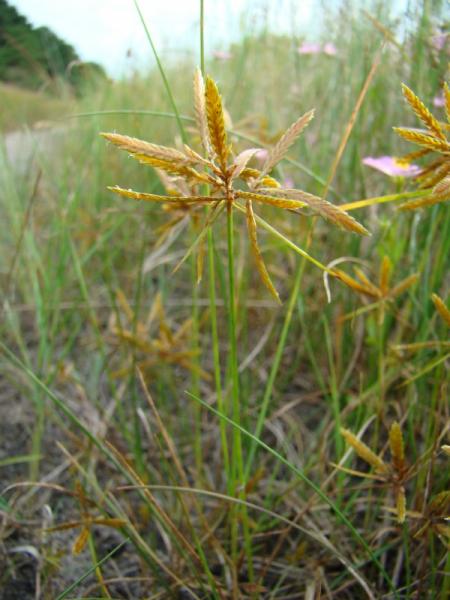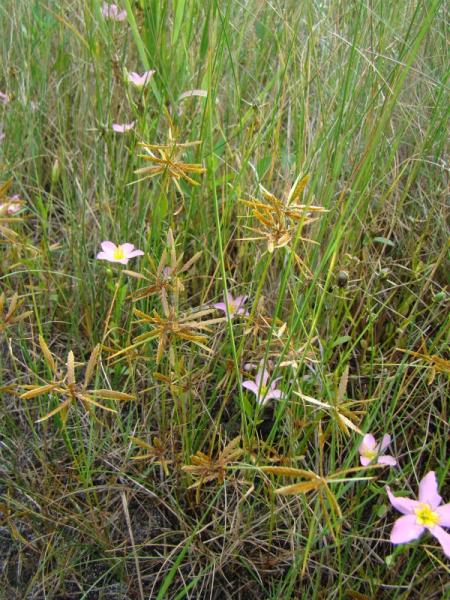Coast Flatsedge
Cyperus polystachyos var. texensis (Torr.) Fern.
- Class
- Monocotyledoneae (Monocots)
- Family
- Cyperaceae (Sedge Family)
- State Protection
- Endangered
Listed as Endangered by New York State: in imminent danger of extirpation in New York. For animals, taking, importation, transportation, or possession is prohibited, except under license or permit. For plants, removal or damage without the consent of the landowner is prohibited.
- Federal Protection
- Not Listed
- State Conservation Status Rank
- S1S2
Critically Imperiled or Imperiled in New York - Especially or very vulnerable to disappearing from New York due to rarity or other factors; typically 20 or fewer populations or locations in New York, very few individuals, very restricted range, few remaining acres (or miles of stream), and/or steep declines. More information is needed to assign either S1 or S2.
- Global Conservation Status Rank
- G5T5
Secure globally - Both the species as a whole and the subspecies/variety are common in the world; widespread and abundant (but may be rare in some parts of its range).
Summary
Did you know?
While mostly known from Suffolk County there were two collections of this rare flatsedge from Queens County in the 1890s. It was not collected in Queens again until 2004 when it was found around a small pond near the South Shore of Long Island, a span of over 100 years between sightings!
State Ranking Justification
There are six existing populations but only two of them have over 100 plants. One population from 1989 has been overrun by Phragmites. There are seven records from the early 1900s through 1975 that have not been rediscovered but habitat still remains. Four populations from Western Long Island and Staten Island are now gone because they occurred in natural areas which no longer exist.
Short-term Trends
One population discovered in 1989 has been destroyed by Phragmites and other populations are threatened by it. Most populations have not been resurveyed and their short-term status is unknown.
Long-term Trends
This plant has always been rare in New York but the populations have declined in the last 100 years and may continue to decline. Many saltmarshes on Western Long Island and the New York City area have been developed or drained and habitat no longer exists. Phragmites is affecting present-day saltmarshes.
Conservation and Management
Threats
The failure to control the invasion of Phragmites and the failure to provide buffers from nearby developments that affect the quality of runoff and remove natural buffers are the largest threats.
Conservation Strategies and Management Practices
Control Phragmites invasions in the salt marshes where it exists and prevent new incursions. Natural buffers should be established around the salt marshes to decrease pollution runoff and other direct human disturbances.
Research Needs
Research is needed to discover habitat preferences that would allow the augmentation of existing populations.
Habitat
Habitat
In New York, Coast Flatsedge grows in open, wet, sandy habitats influenced by saltwater, including high salt marshes, brackish meadows, pond shores, and roadside ditches (New York Natural Heritage Program 2010). Shores, ditches, swales between dunes (FNA 2002). Tidal river banks (Rhoads and Block 2000). Wet soil, mostly near the coast (Gleason and Cronquist 1991).
Associated Ecological Communities
- Brackish meadow
(guide)
A moist, moderately well-drained brackish (salinity 0.5-18 ppt) perennial grassland with occasional isolated shrubs that is typically situated in a belt at the upper edge of salt marshes bordering sandy uplands, but may occupy large portions of interdunal basins. The community usually develops in areas with a unique combination of soils and hydrology, on deep deposits of periodically windblown or overwashed gleyed sands that are usually flooded only during spring tides and during major coastal storms, approximately two to three times per year.
- Coastal plain pond shore
(guide)
The gently sloping shore of a coastal plain pond with seasonally and annually fluctuating water levels. Plants growing on the pond shore vary with water levels. In dry years when water levels are low there is often a dense growth of annual sedges, grasses, and herbs. Submerged and floating-leaved aquatic plants, such as fragrant waterlily and pondweeds, may become "stranded" on the exposed shore. In wet years when the water level is high only a few emergents and floating-leaved aquatics may be noticeable. T
- High salt marsh
(guide)
A coastal marsh community that occurs in sheltered areas of the seacoast, in a zone extending from mean high tide up to the limit of spring tides. It is periodically flooded by spring tides and flood tides. High salt marshes typically consist of a mosaic of patches that are mostly dominated by a single graminoid species.
- Saltwater tidal creek*
(guide)
The aquatic community of a shallow, tidally flooded saltwater or brackish creek with submerged areas averaging less than 2 m (6 ft) deep at low tide.
* probable association but not confirmed.
Associated Species
- Agalinis purpurea (purple agalinis)
- Agrostis perennans (autumn bent)
- Arctostaphylos uva-ursi (bearberry)
- Atriplex patula (spear orach)
- Baccharis halimifolia (groundsel-tree)
- Bulbostylis capillaris (tufted hair sedge)
- Cyperus diandrus (umbrella flat sedge)
- Distichlis spicata (salt grass)
- Fimbristylis castanea (marsh fimbry)
- Iris pseudacorus (yellow iris)
- Iva frutescens (salt marsh-elder)
- Juncus gerardii
- Limonium carolinianum (sea-lavender)
- Minuartia caroliniana
- Mollugo verticillata (carpetweed)
- Myrica gale (sweet gale)
- Myrica pensylvanica
- Panicum virgatum (switch grass)
- Paspalum setaceum
- Phragmites australis (old world reed grass, old world phragmites)
- Pinus rigida (pitch pine)
- Plantago maritima var. juncoides (seaside plantain)
- Pluchea odorata (salt marsh-fleabane)
- Prunus serotina
- Pycnanthemum muticum (short-toothed mountain-mint)
- Sabatia stellaris (sea-pink)
- Salicornia bigelovii (Bigelow's glasswort)
- Salicornia depressa (slender glasswort)
- Salsola kali
- Schizachyrium scoparium
- Schoenoplectus americanus (chair-maker's bulrush)
- Scutellaria galericulata (marsh skull-cap)
- Solidago sempervirens (northern seaside goldenrod)
- Spartina alterniflora (smooth cord grass)
- Spartina patens (salt-meadow cord grass)
- Strophostyles helvula
- Symphyotrichum tenuifolium var. tenuifolium (perennial salt marsh-aster)
- Teucrium canadense (American germander)
- Triadenum virginicum
- Triglochin maritima (sea arrow-grass)
- Viburnum dentatum var. venosum (southern arrowwood)
Range
New York State Distribution
This flatsedge was historically known from Staten Island and across Long Island but current records exist only in Queens and eastern Suffolk counties including Fishers Island.
Global Distribution
This flatsedge occurs along the Atlantic and Gulf coastal plain from southern Maine to Florida. It is also common inland from Virginia to Missouri and Oklahoma south to Texas.
Identification Comments
General Description
Coast Flatsedge is a perennial, grass-like herb. Its stems are slender (up to 2 mm wide), 3-sided or more or less rounded, and up to 45 cm tall. It has 6 to 10 flat or V-shaped leaves, 1 to 4 mm wide and up to 30 cm long. The infloresence is subtended by 4 to 6 horizontal to ascending leafy bracts, and consists of a single spike. The spike may be either a single dense cluster of (15 to 30) spikelets or have the spikelets held on from 1 to 8 rays (branches) up to 3 cm long. The pistillate scales are straw-colored to light brown with a green stripe in the middle and a pointed tip. The fruit are laterally compressed, biconvex, minutely pitted achenes about 1 mm long (FNA 2002).
Best Life Stage for Proper Identification
Coast Flatsedge is best identified when in mature fruit.
Similar Species
Cyperus flavescens and C. filicinus also have 2 sided achenes and light-colored pistillate scales. C. flavescens has relatively wider, egg-shaped pistillate scales about twice as long as wide, and C. filicinus has longer scales (2.5 to 3.5 mm long). Cyperus polystachyos var. texensis (our only variety in New York) has narrow (3 times as long as wide) and short (1.5 to 2.3 mm) pistillate scales (Gleason and Cronquist 1991).
- Fruiting
The time of year you would expect to find Coast Flatsedge fruiting in New York.
Coast Flatsedge Images
Taxonomy
Coast Flatsedge
Cyperus polystachyos var. texensis (Torr.) Fern.
- Kingdom Plantae
- Phylum Anthophyta
- Class Monocotyledoneae
(Monocots)
- Order Cyperales
- Family Cyperaceae (Sedge Family)
- Order Cyperales
- Class Monocotyledoneae
(Monocots)
- Phylum Anthophyta
Additional Common Names
- Cyperus
- Flat Sedge
Additional Resources
Best Identification Reference
Flora of North America Editorial Committee. 2002. Flora of North America, North of Mexico. Volume 23. Magnoliophyta: Commelinidae (in part): Cyperaceae. Oxford University Press, New York. 608 pp.
Other References
Fernald, M. L. 1950. Gray's manual of botany. 8th edition. Corrected printing (1970). D. Van Nostrand Company, New York. 1632 pp.
Gleason, Henry A. and A. Cronquist. 1991. Manual of Vascular Plants of Northeastern United States and Adjacent Canada. The New York Botanical Garden, Bronx, New York. 910 pp.
Holmgren, Noel. 1998. The Illustrated Companion to Gleason and Cronquist's Manual. Illustrations of the Vascular Plants of Northeastern United States and Adjacent Canada. The New York Botanical Garden, Bronx, New York.
New York Natural Heritage Program. 2010. Biotics database. New York Natural Heritage Program. New York State Department of Environmental Conservation. Albany, NY.
New York Natural Heritage Program. 2024. New York Natural Heritage Program Databases. Albany, NY.
Weldy, T. and D. Werier. 2010. New York flora atlas. [S.M. Landry, K.N. Campbell, and L.D. Mabe (original application development), Florida Center for Community Design and Research http://www.fccdr.usf.edu/. University of South Florida http://www.usf.edu/]. New York Flora Association http://newyork.plantatlas.usf.edu/, Albany, New York
Links
About This Guide
Information for this guide was last updated on: November 4, 2011
Please cite this page as:
New York Natural Heritage Program. 2024.
Online Conservation Guide for
Cyperus polystachyos var. texensis.
Available from: https://guides.nynhp.org/coast-flatsedge/.
Accessed July 27, 2024.


